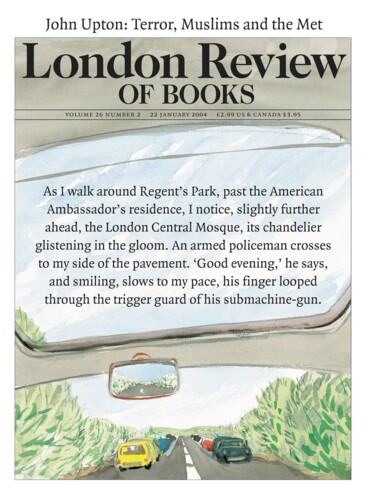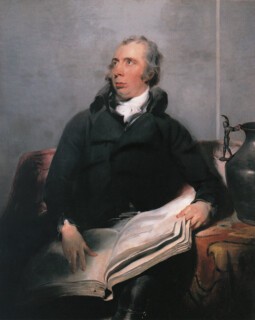Two newly set-out galleries in the British Museum raise questions about collections and what you can do with them. ‘Living and Dying’ fills the space which joins the Great Court with the north entrance to the Museum. The glass cases which tower towards the ceiling contain items from the ethnographic collections. A display like a shop counter runs the length of the gallery and shows a single person’s lifetime consumption of pills stitched into a gauzy runner. This is annotated by snapshots purporting to show scenes from ordinary lives. The theme of the gallery is cultural difference, and the objects illustrate responses to events, common to all people and all peoples, which punctuate the time between birth and death. It is very well done: the resources of the Museum are such that all the objects have an abundant life of their own. This makes the quality of the connections between, say, a Bolivian dance mask and a wooden pillow from Zimbabwe unimportant.
In Robert Smirke’s King’s Library of 1828, now divested of the books it was built to house, there is a new gallery called ‘Enlightenment’.* On the shelves and in display cases you find a stuffed toucan, a Chinese brush pot, an engraving of Stonehenge, three babies carved in ivory (thought once to show how triplets arranged themselves in the womb), Hawaiian clubs, masks from the American Northwest, pots and a sacrificial altar from Central America, a stuffed penguin, mounted prisms, clocks, microscopes, impressions of seals, engravings, Roman grave markers, a Babylonian mud brick (the straw clearly showing), pressed plants, botanical illustrations and so on. The range is immense. What is on display is a sampling of a great collection of collections. Among them travellers’ collections of plants, birds and animals; antiquaries’ collections of seal impressions and coins; and a wealthy, reclusive, non-practising clergyman’s collection of engraved gems and minerals. These things are presented as evidence of the way in which, as old ideas were being questioned in the 18th century, materials for a new way of describing the world were being gathered together.
Although some things in ‘Living and Dying’ are high up and hard to see, all of them expect and deserve individual attention. In the second gallery much of the abundance is atmospheric or repetitive. There are things here which are not offered for serious interrogation. They fill the lower and upper shelves of dimly lit cases like the dusty bottles and books no one is going to read which clutter high places in theme pubs. The perfunctoriness of some of the labels here (where and when was the bird collected? What does the inscription say?) indicates that the history of the objects themselves is not quite the point.
The character of the two displays is, in part at least, determined by the spaces they occupy. The first is new. The fittings are designed for the objects shown there; their arrangement acknowledges that the gallery is also a corridor, but the building itself remains unobtrusive. The pompous, splendid Library, on the other hand, visually overwhelms its contents. The contrast between the two suggests how well a new building would have suited the Museum. It makes one wonder whether, rather than moving the British Library, it would not have been better to move the objects, and slot new library technologies into the old museum galleries: after all, during the first decades of its existence the Museum was dominated by the Library, which took up far more space than the collections, and the books stayed when natural science found specialised accommodation in South Kensington and oil paintings in Trafalgar Square.
The themes of ‘Enlightenment’ (‘Classifying the World’, ‘Art and Civilisation’, ‘The Natural World’ and so on) are clearly intended to give a sense that collecting was an intellectual activity: that some at least of the light spread by the Enlightenment was the result of looking. Yet the display also reveals collecting’s obsessive side, which in its final, pathological stages turns into an inability to throw things away rather than a capacity for rational assembly and arrangement. The tyranny of things, the weight of possessions, the burden of material culture can be felt. I began to envy the tribes (those in Papua New Guinea, for example, whose artefacts are on display in ‘Living and Dying’) who prepare masks and costumes for a ceremony and burn them when it is over. I can sympathise with those distinguished men of letters who, with death approaching, make bonfires. I think about funeral pyres, recycling bins, weeded government archives and lost works. I wish I, too, was good at discarding things.
The gallery encourages such thoughts partly because the triumphs of scholarship represented by the things on display were not, on the whole, visual. The classification of plants progressed more by way of Latin descriptions than pictures. Joseph Banks commissioned engravings of the beautiful botanical drawings Sydney Parkinson made during Cook’s expedition to the South Seas; but far more important in the advancement of botany was the encouragement Banks gave to Robert Brown, whose unillustrated flora of Australia and Tasmania can, according to Bengt Jonsell in Enlightening the British: Knowledge, Discovery and the Museum in the 18th Century,† be ‘justly regarded as the birthplace of global taxonomy in botany’, its significance inverse to its modest physical appearance. Similarly, in the sections on philology it is not the raw material that is wonderful but the discoveries it made possible. The replica of the Rosetta Stone one is invited to touch has the magic of a relic, but it is not a thing of beauty; the copying of inscriptions and the untangling of hieroglyphs and syllabaries make for an exciting narrative, but the working papers and cylinder seals on show are visually unimpressive. The thought celebrated in these displays created a structure within which the omnivorous curiosity exemplified by the cabinet of curiosities could be disciplined. The embedding of the displays in a setting with its own architectural claims on our respect and attention makes it difficult to take them as anything but curiosities. Mary Delany’s paper mosaics of flowers are charming, but they are distractions from, rather than illustrations of, the intellectual endeavours that the word ‘enlightenment’ points to – for example, the conflict between the simple utility of Linnaeus’ sexual classification of plants and the more intractable natural systems that led to an evolutionary ordering of families and species. Such ideas are hard to put across in disjunct labels to visually plain material, particularly when the physical context is the fittings (bookshelves and display cases) of an early 19th-century library.
Keith Thomas, in an afterword to Enlightening the British, talks about the way the assumptions that underwrote the foundation of the British Museum have changed. One purpose – ‘advancement and improvement’ – has given way to another: ‘pleasure, interest or instruction’. ‘Living and Dying’ is indeed pleasurable, interesting and instructive. If ‘Enlightenment’ is less so it is because it neither gives itself over wholeheartedly to presenting things delightful in themselves nor takes on the task of explaining the development of the disciplines which would make it possible to order plants, animals, rocks, faiths, languages and civilisations. This would have had more than a whiff of improvement about it.
There is, lurking among the things in ‘Enlightenment’, another, more limited display which would have suited the space much better. It could have been called something like ‘The Gentleman’s Library in the 18th Century’. It would take as its starting point Zoffany’s picture of Charles Townley’s library, which shows Townley and some friends standing and sitting among the marbles he had collected (they were acquired early on by the Museum) or Reynolds’s portrait of Sir William Hamilton Seated with the Publication of His Vases. It would still include books like Hamilton’s. Stuart and Revett’s Antiquities of Athens would also figure, as would George III’s medals, and any number of the ancient gems, coins, vases and small bronzes. There would be colour-plate books of natural history, and travel books. Banks would still be represented, but Richard Payne Knight (philologist, numismatist, antiquary, member of the Society of Dilettanti, and author of A Discourse on the Worship of Priapus and An Analytical Inquiry into the Principles of Taste), whose 1794 portrait by Thomas Lawrence is shown here, would be central. There would be more archaeology than natural science, more Greek sculpture than specimens in jars. One lesson of such an exhibition would be that important ideas map indifferently onto fine things. They come in dull little books, not illustrated folios; the evidence for them is more likely to be found in clay than gemstone, in finches not birds of paradise.
Send Letters To:
The Editor
London Review of Books,
28 Little Russell Street
London, WC1A 2HN
letters@lrb.co.uk
Please include name, address, and a telephone number.


